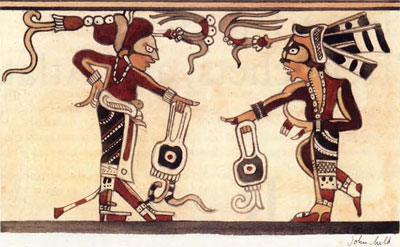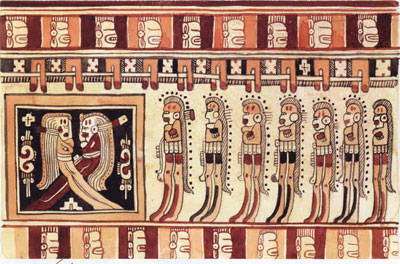
The old cliché that museums and archives are full of undiscovered treasures is true. Though one works constantly to identify and catalog the materials stored therein, there are items that, until the propitious eye of an outside observer comes along, escape detection and revelation. Dr. Elin Danien, an expert in the archaeology of the ancient Maya and research associate of the Museum, recently discovered three watercolors in the Archives by John Held, Jr. (1889-1958), the famous illustrator who epitomized the Jazz Age.
One of the outstanding collections of the Archives is a series of over 200 watercolors of Maya pottery painted between 1910 and 1935. The collection comprises work by several artists, mostly by M. Louise Baker, Museum artist from 1908 to 1936, who is best known for her illustrations of the artifacts uncovered at Ur, Iraq, for the publications by the great archaeologist Sir Leonard Woolley (1880-1960); and by Annie G. Hunter, a British artist who illustrated the work of the pioneer archaeologist of the ancient Maya, Sir Alfred P. Maudslay (1850-1931).
Theses paintings were made at the behest of George Byron Gordon, Museum director from 1910 to 1927, who designed a publication of faithful, yet artistic, renderings of the best examples of Maya pottery to be found in public and private collections around the world. Originally planned to be issued in four parts, with twenty-five plates each and minimal captions, the project was unfortunately cut short by Gordon’s death in 1927. Two portfolios were issued under his editorship, while a third, comprising only sixteen plates, was published by J. Alden Mason, curator of the American Section, 1926-1955. Most of the paintings have never been published. It was while studying the collection that Dr. Daniel found the three paintings by John Held.

John Held, Jr., was born in Utah. He received no formal training in art, but was taught by his father, an artist and musician, and the sculptor Mahonri M. Young, also from Utah. In 1910 he moved to New York to seek his fortune. He initially worked in advertising, but soon became known for his caricatures and cartoons. He sold artwork to The New Yorker, Vanity Fair, Judge, and Lift. His most famous creations were Betty Coed, “the flapper,” and her escort Joe College, the rebellious and fun-loving youth that symbolize the “roaring twenties.” Held became rich from his work, but lost it all after the stock market crash of 1929. He continued to work and create art until his death, though he never regained commercial success.
Held had a brief interlude in 1917-1918 as an archaeological illustrator and draftsman working for the great Mayanist Sylvaneus G. Morley on a Carnegie Institution expedition to Central America. The trip was also a cover for a World War I spy mission for the U.S. Navy. Both Held and Morley were under orders to map the movements of German U-boats spotted in the area.
Artistically the trip was beneficial to Held. He drew much inspiration from the colors and designs of Mesoamerican art, which he later fashioned into his stylized caricatures. Morley’s diary records in detail the three paintings now found in the Museum Archives:
A trip was made in Salvador and the central part of Honduras. Mr. Held made color drawings of the painted vases in the Just Armas collection in San Salvador; and at Tegucigalpa he painted a magnificent specimen of Maya ceramic art from Copan. At San Pedro Sula a fine example of painted ware in the Walker collection from the Ulua Valley was drawn in color.
The paintings were given by Morley to the Museum in 1929, when Mason asked him for recommendations concerning examples of pottery that ought to be included in the Museum’s publication. Morley writes of several pieces that “John Held, who is now the famous cartoonist, as you know, copied in watercolor.” Here, two of these paintings are at last being made available to the public.
Alex Pezzatti, senior archivist
For Further Reading
